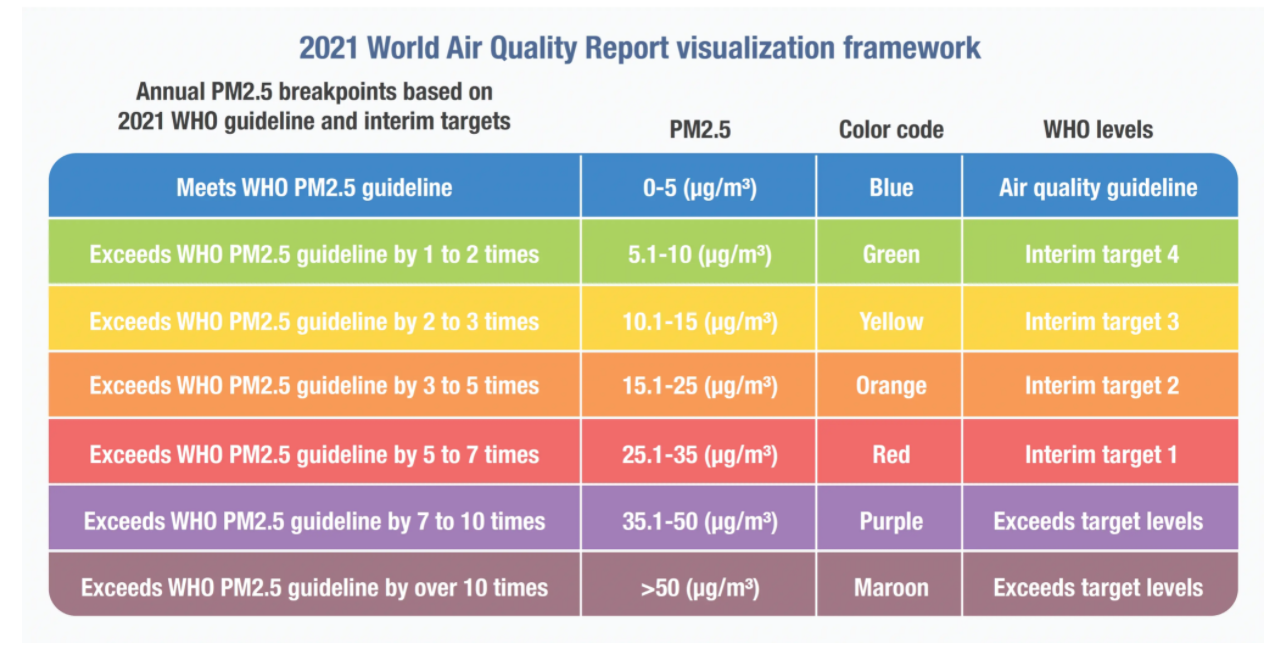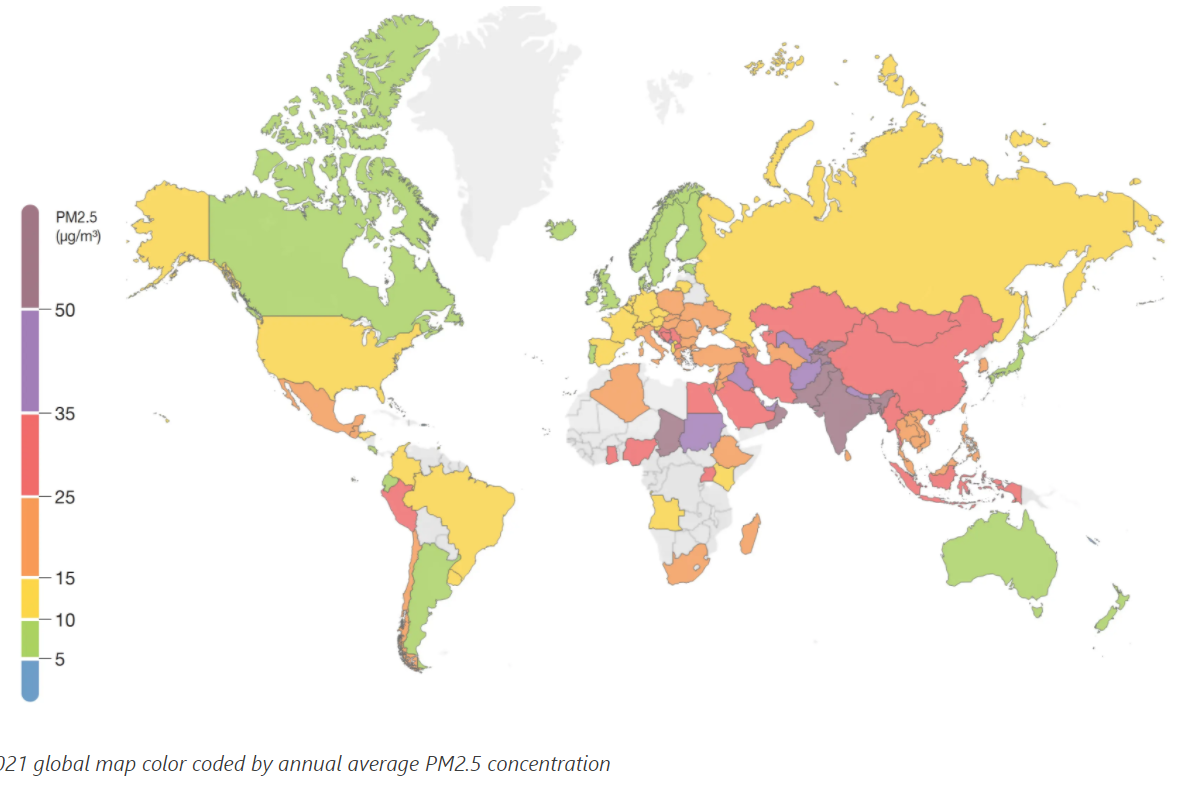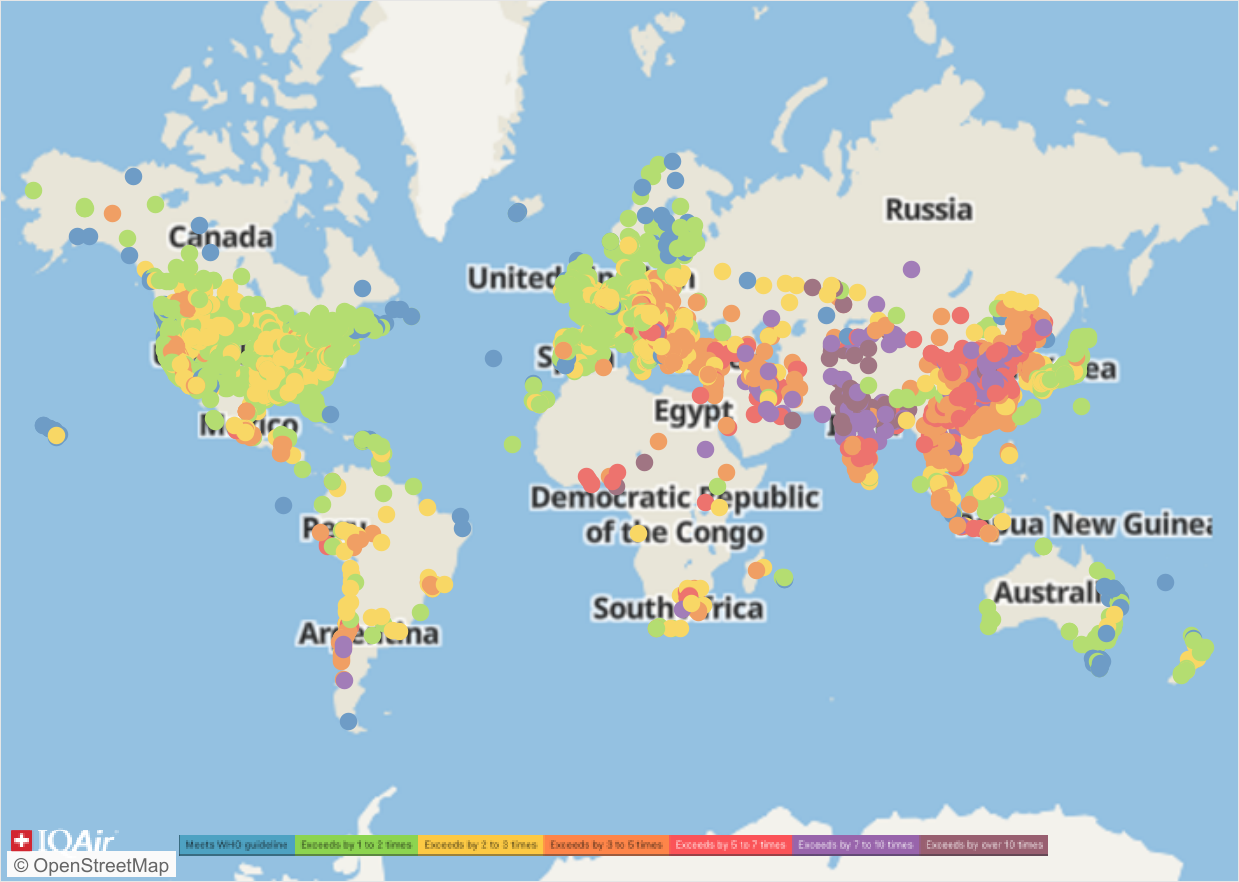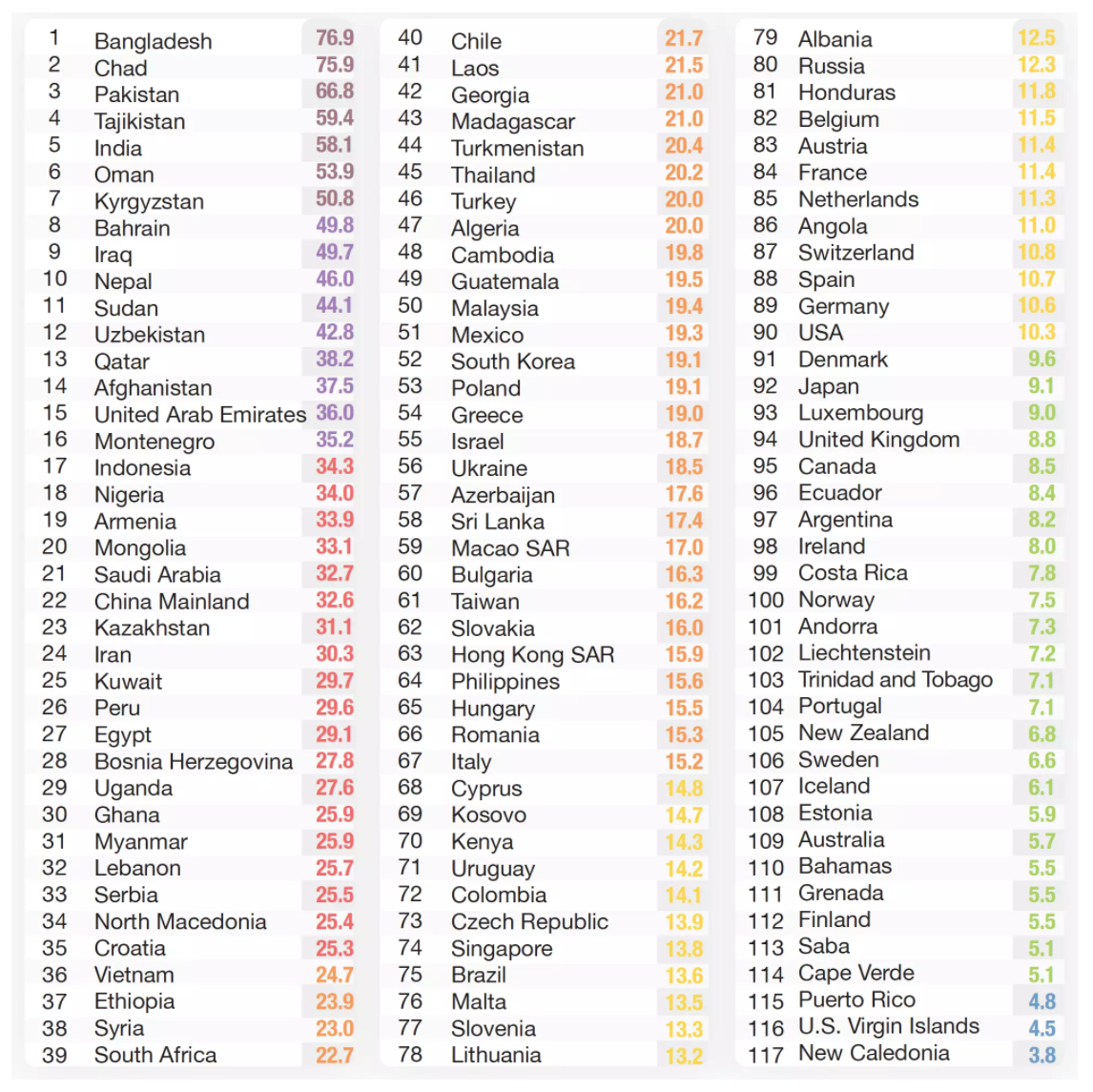

Last week the firm IQAir released its 2021 World Air Quality Report, a survey of the state of global air quality. The report is based on PM2.5 air quality data, noted in micrograms per cubic meter (µg/m³), from monitoring stations in 6,475 cities in 117 countries, regions and territories around the world. The firm found that not one country, not even Western countries, met the World Health Organization’s (WHO) air quality standard for PM2.5 in 2021, and smog even rebounded in some regions after a COVID-related dip.
Reasons vary around the world for not meeting the standard, but transport is a dominant theme that pops up over and over again – from old vehicles that are in use (Euro III or even lower) with dirtier fuels, to the increase in personal driving and trucking. And it’s not just in emerging economies – it’s happening in the West as well. It puts the push to transportation alternatives, including electrification, in perspective.
Consider that PM2.5 is a known human carcinogen and has been linked to nonfatal heart attacks, increased respiratory diseases (including asthma) and premature death in people with heart or lung disease. It is estimated that in 2021, the deaths of 40,000 children under the age of five were directly linked to PM2.5 air pollution. In general, the estimated daily economic cost of air pollution, of which PM2.5 is a big part, has been figured at US$8 billion, or 3 to 4% of the gross world product, according to IQAir. That’s about US$2.92 trillion annually. Compare that to the $755 billion spent on deploying low carbon energies last year, and the $125 trillion required globally to hit net zero targets by 2050, according to the United Nations Framework Convention on Climate Change (UNFCCC).
In September 2021, WHO updated its global air quality guidelines, 15 years after the last update released in 2006. Acknowledging the significant impact of air pollution on global health, the WHO cut the recommended annual PM2.5 concentration by half, from 10 µg/m³ down to 5 µg/m³, with the ultimate goal of preventing millions of deaths. The IQAir report uses seven color bands, shown in the figure below, to provide an easy identification of multiples of the 5 µg/m³ WHO PM2.5 guideline, and the interim target levels.

Source: IQAir, March 2022
Countries and regions in East Asia, Southeast Asia, and South Asia suffered from the highest annual average PM2.5 concentration weighted by population, shown in the figure below. Notably, the African continent had only 13 out of 54 countries with sufficient public air quality monitoring data, resulting in a majority of countries showing in gray. The Latin America and Caribbean region also lacked sufficient monitoring.

Source: IQAir, March 2022
Another view of the data, shown in the figure below, shows the WHO guidelines by cities around the world.

Source: IQAir, March 2022
Population weighted, 2021 average PM2.5 concentration (μg/m³) for countries, regions, and territories in descending order are shown in the figure below.

Source: IQAir, March 2022
The region of East Asia included data from 1,347 cities, according to IQAir. Of these cities, 143, or about 11%, had annual average PM2.5 concentrations greater than seven times WHO’s PM2.5 guideline of 5 µg/m³. All 143 cities were located in China. Overall, air quality in China continued to improve in 2021, with data from 66% of Chinese cities showing decreased PM2.5 concentrations compared to 2020. In 2021, air pollution in the capital city of Beijing continued a five-year trend in PM2.5 reductions and marked the first time the city achieved its own air pollution targets.
Rapid population growth and the accompanying economic development have been significant factors contributing to increased air pollution in Southeast Asia. Oil and coal are the biggest sources of fuel in the power sector, and with the demand for electricity expanding at a rate of approximately 6% per year, the combustion of fossil fuels is a primary contributor to PM2.5. Other PM2.5 sources in urban areas include construction, industrial emissions and transportation. Rural PM2.5 emission sources include open burning practices used to manage farmland and clear forests.
India was home to 11 of the 15 most polluted cities in Central and South Asia in 2021, according to the IQAir report. Delhi saw a 14.6% increase in PM2.5 concentrations in 2021 with levels rising to 96.4 µg/m³ from 84 µg/m³ in 2020. No cities in India met the WHO air quality guideline of 5 µg/m³. In 2021, 48% of India’s cities exceeded 50 µg/m³, or more than 10 times the WHO guideline. It is estimated that 20% to 35% of total urban PM2.5 concentrations is directly or indirectly due to internal combustion engines in motor vehicles.
Annual vehicle sales in India are expected to increase, with an estimated fleet number reaching 10.5 million in 2030. In an effort to curtail the contribution to air pollution from motor vehicles, India has adopted rigorous vehicle emission standards for new vehicles. The BS-VI standard is currently equivalent to the Euro 6-1 standard and will be equivalent to the Euro 6-2 standard beginning in April 2023. Emissions testing methodologies capable of measuring emissions under real-world driving conditions, rather than more simple laboratory drive cycles, are in development at the International Centre for Automotive Technology in India with an anticipated release of 2023.
The region of Europe is represented by 42 countries in 2021 and a total of 1,588 cities, according to the report. Average PM2.5 concentrations in this region span from 5.5 µg/m³ in Finland (ranked globally at 113) to 35.2 µg/m³ in Montenegro (ranked globally at 16). PM2.5 concentration data for both 2020 and 2021 was available for 39 European countries. In 2021, air quality improved in 14 countries and declined in 25 countries compared to 2020. Region-wide, only 55 cities were able to meet the recommended 5 µg/m³ WHO PM2.5 annual air quality guideline. The United Kingdom was home to ten cities achieving the guideline, more than any other country in the region, followed by Finland which had eight cities achieve the guideline.
Air quality monitoring networks in both the United States and Canada grew in North America 2021, as did emissions in the two nations. In 2021, 96% of U.S. and Canadian cities were not able to get below the WHO annual 5 μg/m³ guideline for PM2.5 levels, with those cities accounting for more than 98% of the region’s population. The main sources of pollution were gas and diesel-powered transportation, coal-based energy production, industrial emissions, and wildfires.
Latin America and the Caribbean have faced several air quality challenges as regional cities grow and urban populations expand. Urban population growth is a multifaceted air quality issue: as demand for energy and transportation increases, so do PM2.5 emissions. Increases in fossil fuel-generated energy production, vehicle exhaust from outdated vehicle fleets, the rising use of solid-state fuels as a heat source in lower income cities, and the absence of governmental air quality regulation all contribute to poor air quality. Despite all this, the region of Latin America and the Caribbean has made some progress in 2021. Country level PM2.5 concentrations fell in four regional countries: Argentina, Brazil, Colombia, and Costa Rica, according to the report.
Chile hosts 11 of the top 15 most polluted cities in Latin America and the Caribbean, where nine out of 10 people live in cities. In 2021, only one Chilean city met the 2021 WHO air quality guideline leaving 99% of the regional population in areas that exceed the guideline by a factor of five. Efforts are being made to reduce emissions in the region, but more than 90 million people still rely on polluting fuels for cooking and heating.
Sparse air quality data makes gauging the exact extent of Africa’s air pollution problem difficult. Additionally, the task of measuring the health impacts from dirty air also remains difficult. It is calculated that air pollution is the cause of an estimated 780,000 African deaths a year. Windblown dust from deserts is a common source of PM2.5 pollution in Africa. So too are fossil fuel combustion, waste, and agricultural burning. With the African population predicted to double in the next 30 years, rapid transportation growth, industrialization, and urbanization is likely to negatively impact regional air quality.
Oceania has the cleanest overall air quality in the world. Yet, typical challenges to air quality in the region can include brushfires and dust storms originating from Australia’s desert interior. Forty-six cities in Australia, one in New Zealand, and one in New Caledonia all met the WHO PM2.5 air quality guideline of 5 µg/m³. However, a further 63 cities in Australia and 20 in New Zealand failed to meet this standard, impacting the health of over 21 million people.
Tammy Klein is a consultant and strategic advisor providing market and policy intelligence and analysis on transport energy to the auto and oil industries, alternative fuels industries, governments and NGOs. She writes and advises on petroleum fuels, biofuels and other alternative fuels, and fuels policy, market and technology issues.